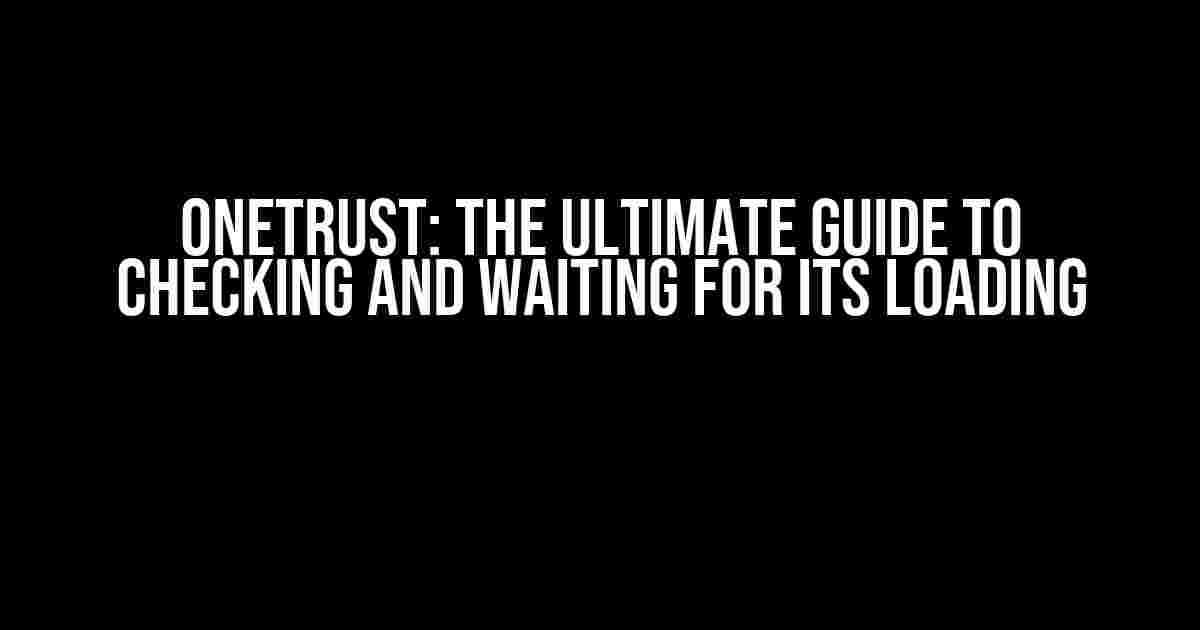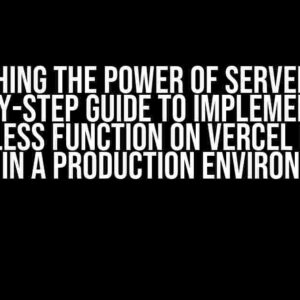Are you tired of dealing with inconsistent user consent experiences? Do you struggle to ensure compliance with data privacy regulations? OneTrust is here to help! As a leading trust intelligence platform, OneTrust empowers organizations to build trust with their customers by providing seamless consent management, data protection, and risk management solutions. In this comprehensive guide, we’ll dive into the world of OneTrust and explore how to check if it’s used in a project and wait for it to fully finish loading.
What is OneTrust?
Before we dive into the nitty-gritty, let’s quickly overview what OneTrust is. OneTrust is a cutting-edge trust intelligence platform designed to help organizations build trust with their customers by providing a suite of solutions that address data privacy, security, and compliance. With OneTrust, businesses can manage customer consent, protect sensitive data, and mitigate risks associated with data breaches and non-compliance.
Why Use OneTrust?
There are numerous reasons why organizations should consider using OneTrust. Here are just a few:
- Streamlined Consent Management: OneTrust simplifies the consent management process, ensuring that customers’ preferences are respected and compliant with data privacy regulations.
- Data Protection: OneTrust provides robust data protection solutions that safeguard sensitive customer data and prevent unauthorized access.
- Risk Management: OneTrust’s risk management capabilities enable organizations to identify and mitigate potential risks associated with data breaches and non-compliance.
- Compliance and Regulation: OneTrust ensures compliance with major data privacy regulations, such as GDPR, CCPA, and LGPD.
Checking if OneTrust is Used in a Project
So, how do you check if OneTrust is used in a project? Follow these simple steps:
- Review Project Dependencies: Start by reviewing the project’s dependencies and libraries. Check the package.json file (if using Node.js) or the Gemfile (if using Ruby) for any mentions of OneTrust.
- Inspect HTML Code: Inspect the HTML code of the project’s website or application. Look for any scripts or tags that reference OneTrust, such as
<script src="https://cdn.onetrust.com/..."></script>. - Check for OneTrust Cookies: Verify if the project’s website or application sets any OneTrust-related cookies. You can use the browser’s developer tools or a cookie inspector extension to do so.
- Consult with the Development Team: If you’re still unsure, consult with the development team or the project stakeholders to confirm if OneTrust is used in the project.
Waiting for OneTrust to Finish Loading
Now that you’ve confirmed OneTrust is used in the project, it’s essential to ensure that it has fully finished loading. Here’s how:
function waitForOneTrust() {
let oneTrustInterval = setInterval(() => {
if (window.OneTrust && window.OneTrust.isReady) {
clearInterval(oneTrustInterval);
console.log("OneTrust has finished loading!");
// Perform actions that rely on OneTrust being fully loaded
}
}, 100);
}This code snippet sets up an interval that checks every 100 milliseconds if the OneTrust script has finished loading and is ready to use. Once it is, the interval is cleared, and any subsequent actions can be performed.
Common Scenarios: When to Wait for OneTrust
Here are some common scenarios where waiting for OneTrust to finish loading is crucial:
| Scenario | Description |
|---|---|
| Personalization and Targeting | OneTrust ensures that personalization and targeting efforts are compliant with users’ consent preferences. |
| Data Analytics and Reporting | OneTrust provides accurate and compliant data analytics and reporting by respecting users’ consent choices. |
| Cookie Management and Tracking | OneTrust’s cookie management and tracking capabilities ensure that cookies are set and tracked in accordance with users’ consent. |
| Form Submissions and Lead Generation | OneTrust ensures that form submissions and lead generation activities are compliant with data privacy regulations and users’ consent preferences. |
Best Practices for Working with OneTrust
To get the most out of OneTrust, follow these best practices:
- Implement OneTrust Early: Integrate OneTrust into your project as early as possible to ensure seamless consent management and data protection.
- Configure OneTrust Correctly: Take the time to configure OneTrust correctly, ensuring that it aligns with your organization’s data privacy policies and compliance requirements.
- Test OneTrust Thoroughly: Perform comprehensive testing to ensure that OneTrust is functioning correctly and not causing any issues with your application or website.
- Monitor OneTrust Performance: Regularly monitor OneTrust’s performance and adjust configurations as needed to ensure optimal performance and compliance.
Conclusion
In conclusion, OneTrust is a powerful tool for managing customer consent, protecting sensitive data, and mitigating risks associated with data breaches and non-compliance. By following the instructions outlined in this guide, you’ll be able to check if OneTrust is used in a project and wait for it to fully finish loading. Remember to implement OneTrust early, configure it correctly, test it thoroughly, and monitor its performance to ensure seamless compliance and data protection. With OneTrust, you can build trust with your customers and stay ahead of the competition.
Did you find this guide helpful? Share your thoughts and experiences with OneTrust in the comments below!
Frequently Asked Question
Get answers to the most common questions about OneTrust and its role in your project.
What is OneTrust and why is it used in my project?
OneTrust is a popular consent management platform that helps organizations comply with data privacy regulations like GDPR, CCPA, and LGPD. It’s used in your project to manage user consent, provide transparency, and ensure compliance with data protection laws.
Why do I need to wait for OneTrust to finish loading?
OneTrust needs time to load and configure itself to ensure that all necessary consents and permissions are in place. If you don’t wait for it to finish loading, you risk compromising the integrity of your project’s data protection mechanisms, which could lead to legal and reputation issues.
How long does it take for OneTrust to finish loading?
The loading time for OneTrust can vary depending on factors like your project’s complexity, the number of integrations, and your network connection. On average, it takes around 10-30 seconds for OneTrust to finish loading, but it’s essential to wait until it’s fully loaded to ensure a smooth experience.
What happens if I don’t wait for OneTrust to finish loading?
If you don’t wait for OneTrust to finish loading, you may encounter issues like incomplete consent records, failed integrations, or even data breaches. This can lead to legal and compliance issues, damage to your brand reputation, and financial losses.
Is there a way to speed up the OneTrust loading process?
While there’s no way to speed up the OneTrust loading process significantly, you can optimize your project’s setup to minimize loading times. Make sure your network connection is stable, and your project’s integrations are well-configured. Additionally, consider using a content delivery network (CDN) to reduce latency and improve overall performance.



